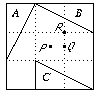If d(x, y) = d(f(x), f(y)) and d(x', y') = d(g(x'), g(y')) then put x' = f(x) and y' = f(y) and it follows that g ∘ f also preserves length.
Closure under inverses works similarly.
To prove that conguence is an equivalence relation:
The reflexive property follows from the fact that the identity map is in the group of rigid motions.
To prove symmetry, suppose that F1 and F2 are conguent and that f(F1) = F2 with f a rigid motion. Then f -1 is also in the group and f -1(F2) = F1 and the result follows.
If F2 and F3 are congruent and g(F1) = F2 then g ∘ f is a congruence between F1 and F3 and transitivity follows.
 Rotation by -π/2 about the centre P maps triangle A to triangle B.
Rotation by -π/2 about the centre P maps triangle A to triangle B.Rotation by π about the centre Q maps triangle B to triangle C.
Rotation by +π/2 about the centre R maps triangle A to triangle C.
Note that the third is the composite of the first two. The composite of two rotations is always another rotation.
In the first case the rotation is about the mid-point of AC, in the second it is about the point C.
A map like (x, y) ↦ (2x, 2y) preserves angles but does not preserve lengths.
SL is the kernel of this homomorphism and hence is a normal subgroup of GL.
Conversely if AtA = I then A has orthonormal columns and is orthogonal.
If AtA = I then At is the left inverse of A and since the left inverse of a square (finite-dimensional) matrix is also a right inverse, it follows that AAt = I also. That is, At has orthonormal columns and so A has orthonormal rows.
[Proving this in a specific case -- even 2 × 2 -- is harder than you might think!]
Since either a or b ≠ 0 assume (without loss of generality) that b ≠ 0.
Then a = -cd/b and a2 + c2 = (cd/b)2 + c2 ⇒ c2(d2 + b2) = b2 ⇒ c2 = b2.
Hence a2 + b2 = a2 + c2 = 1 and c2 + d2 = b2 + d2 = 1.
If c = b then ab + cd = 0 ⇒ ac + bd = 0 and if c = -b then ab + cd = 0 ⇒ a(-c) + (-b)d = 0 ⇒ ac + bd = 0.